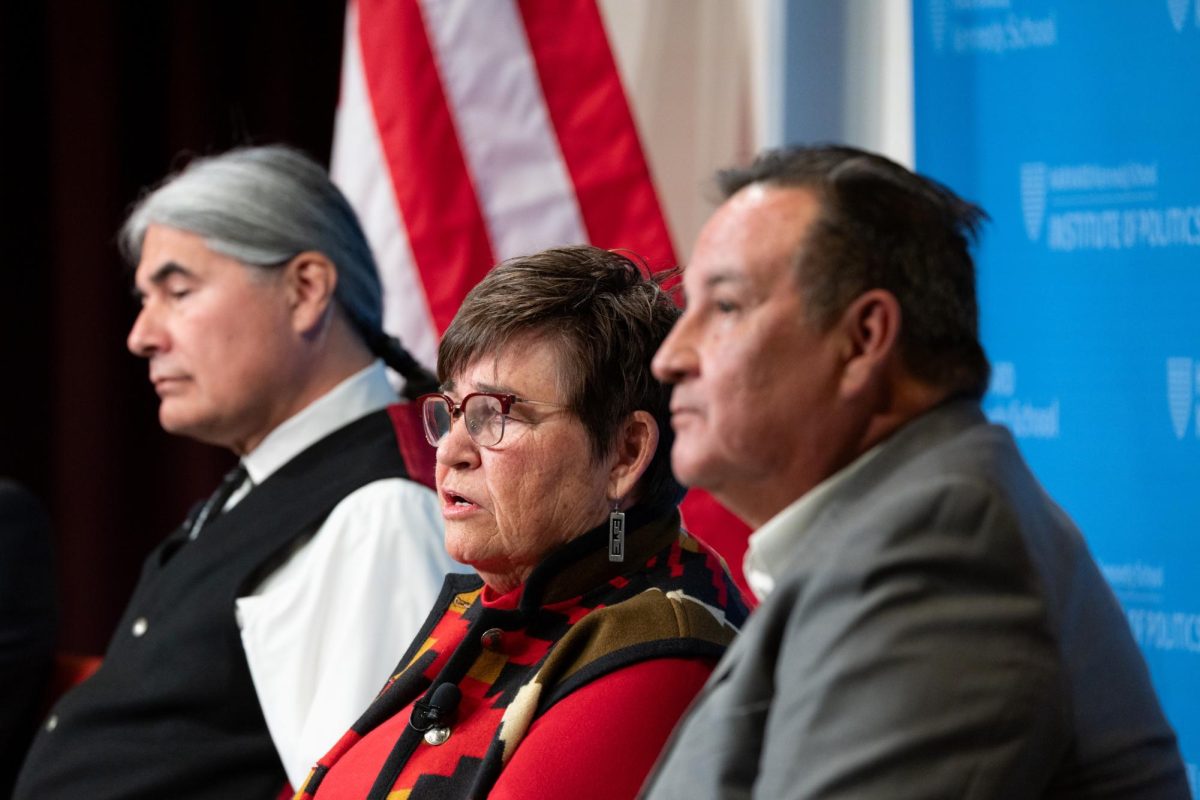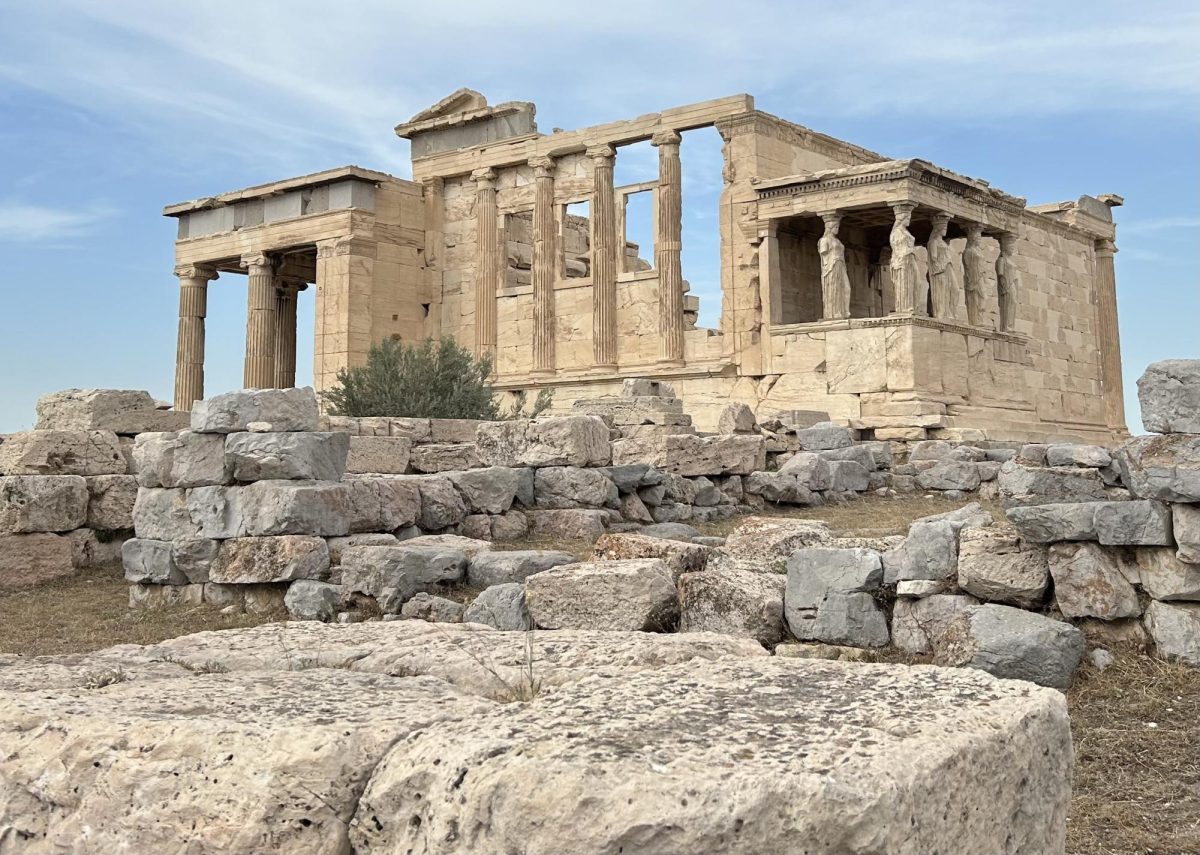A panel discussion at Harvard University addressed the dark history of the Osage Nation’s struggle for sovereignty with the American federal government, with the panel calling attention to modern Osage progress in light of Martin Scorsese’s 2023 film, “Killers of the Flower Moon.”
“We were victims then, but we don’t live like victims today,” said panelist Jim Gray, Chief of the Osage Nation from 2002 to 2010.
The Dec. 4 event at the Institute of Politics at the Harvard Kennedy School featured three leaders of the Osage Nation for the final installment of this year’s John F. Kennedy Jr. Forum, a set of nonpartisan conversations on timely issues. In addition to Gray, the panelists included Hepsi Barnett, a graduate of the Kennedy School and former Chief of Staff for the Osage Nation; Wilson Pipestem, a lawyer and member of Harvard’s Honoring Nations Board of Governors; and, serving as moderator, professor Joe Kalt of the Harvard Kennedy School Project on Indigenous Governance and Development.
The new film, which is based on the book of the same name by New York Times–bestselling author and New Yorker staff writer David Grann, probes the effects of the discovery of oil on Osage land in Oklahoma in 1894, leading the tribe to become one of the world’s richest communities. This prompted white Americans to marry Osages in order to inherit oil shares, leading to the murders of an estimated 60 Osages in the early 1900s by people seeking oil headrights, which were the funds distributed to Osages upon oil extraction. The film follows the real-life murder plot by William Hale (Robert De Niro) and Ernest Burkhart (Leonardo DiCaprio) of the Osage family into which Burkhart had married.
The book and movie have brought new attention to the murders, which were rarely discussed among Osage families. Gray is a descendant of a murdered Osage, and both Pipestem and Barnett had relatives who lived through the period.
“They lived with fear that I never understood until I read the book,” said Pipestem.
With the movie’s release, Osages saw arguably the darkest point in their history played out before them on screen, triggering what Gray called “a cathartic process among Osage people who had been silent about this for most of their lives to somehow embrace it, make peace with it, comes to terms with it, to channel it.”
The film has sparked a range of emotions and conversations within the Osage community and pushed “the tribe harder to greater control over their own story.”
A bulk of the criticism towards the movie has focused on Scorsese, a white man, for having directed a film about indigenous people. However, the panelists emphasized the collaborative process between Osages and filmmakers from the planning stages to the premiere, with a partnership that influenced many of the film’s cultural elements and plot points.
Prior to filming, Scorsese attended a cultural dinner with Osages that panelists remember as an “important evening in the changing of the story,” as it initiated the collaboration.
Gray described how he pleaded with the director for the Osages to “help you make this film because these are our people, these are our ancestors that you’re talking about, and there are some things in the FBI files, and there are some things in David Grann’s book that capture this story, but not all of it.”
The Osage Nation developed in present-day Ohio and the Mississippi River Valley around 700 B.C. from a group of Degihan-Siouan-speaking tribes. Between 1808 and 1825, the Osages lost their land due to westward expansion driven by the American government and were forced into Oklahoma. Unlike other tribes, the Osages purchased their Oklahoma reservation, giving them ownership of the oil-bearing land.
“We had a flourishing, prospering nation of people for thousands of years,” said Barnett. “It was really through failed federal Indian policy that made it possible, that created the situation that made it possible for our people to be murdered in that way.”
The federal effort to regulate the land was seen in the 1906 Osage Allotment Act, which dismantled the Osage government and created a tribal council that, according to Barnett, “didn’t have a lot of power or authority, and really eroded our inherent sovereignty.”
The act additionally divided the mineral estate into shares that passed through inheritance, as well as deemed Osages incompetent to handle their finances. This meant that “guardians” — primarily white men — managed Osage finances and authorized when Osages could spend their money.
“The institutions of colonial government into the affairs of the Osage make us still the most colonized tribal nation in the United States,” said Pipestem. “That’s because of oil and the creation of these laws that said that ‘We’re going to come in here and make sure that you don’t have very much authority to exercise when it comes to your own homeland.’ ”
The Osage Allotment Act still exists, and according to Barnett, the Osages “still suffer as a result of it.” All three of the panelists are labeled legally incompetent to manage their headrights. Additionally, the federal government requires a certain amount of Osage land to be dedicated to oil development. Furthermore, while individuals own Osage land, the United States is a trustee of that land. While the Bureau of Indian Affairs eventually limited the inheritance line of headrights to people of Osage ancestry, around 25 percent of headrights are still owned by non-Osage people.
“Osages today, we are still digging out of that,” said Pipestem.
Much of the Osage Nation’s progress has taken place in the last 20 years, when Gray argued before the Congress for the right to install a new Osage government.
“We organized an entire nation to work together in creating a constitution that built on unity,” said Gray, who oversaw the government rehaul.
The resulting 2006 Constitutional Reform saw the formation of a new Osage Nation government similar to that of the American federal government, now with new citizenship requirements. Previously, the American government required that only shareholders of oil land be citizens, and as of 2006, only around 4,000 of about 20,000 Osages were shareholders. The approximately 16,000 remaining Osages were finally enfranchised as citizens in 2006.
In his closing remarks, Gray said that, with the recent catapult in media publicity, he has “never missed an opportunity, when talking about this film or this dark period in our history,” to “bring it forward to the changes that we’ve made.”
From arguing before Congress to building a democratic government, preserving their previously-dying language, and involving community members in the development of initiatives, Gray said, “we don’t use that darkest moment to define how we are today.”
–Dec. 13, 2023–









